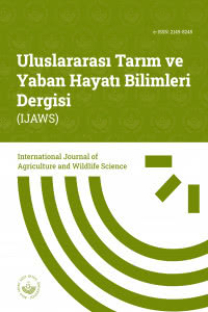Pekin Ördeklerinde Farklı Kuluçka Uygulamalarının Etkileri
Bu araştırmada, entansif şartlarda yetiştirilen Pekin ördeklerinde kuluçka randımanının iyileştirilmesi amacıyla birbirinden bağımsız üç deneme gerçekleştirilmiştir. Kuluçka randımanını yükseltmek amacıyla, kuluçkalık ördek yumurtalarında, depolama süresi(0-7gün ve 7-14gün), yumurta temizliği(temiz, yıkanmış ve kirli) ve spreylemenin etkisi incelenmiştir. Temiz, yıkanmış ve kirli yumurtalardaki kuluçka randımanı sırasıyla %69.38, %62 ve %54.9 olmuştur. 0-7 gün depolanan yumurtalarda %69.49, 7-14 gün depolananlarda %56.7 kuluçka randımanı elde edilmiştir. Ayrıca kuluçka randımanı, spreylenen yumurtalarda %70, spreylenmeyenlerde %58.4 olmuştur. Muamele grupları arasındaki fark istatistik açıdan önemsiz bulunmuştur (p>0.05). Bununla birlikte, spreyleme uygulandığı takdirde, 0-7gün depolanan temiz yumurtalarda en yüksek randımanın alınabileceği açıkça görülmektedir.
Anahtar Kelimeler:
Ördek, inkübasyon, kuluçka randımanı
Effect of Different Hatchery Practices on Pekin Duck
In this research, three different study were carried out for improving hatchability of Pekin ducks. For this purpose, effects of egg storage time (0-7 days and 7-14 days), egg cleaning (clean, washed and dirty) and egg spraying were compared in hatching Pekin duck eggs. Hatchability of clean, washed with of disinfectant and dirty eggs were 69.38%, 62,00% and 54.90%, respectively. Obtained hatchability in stored hatching duck eggs were 69.49% for 1-7 days, and 56.70% for 8-14 days. In addition, hatchability was 70.00% in sprayed eggs to increase hatchability and 58.40% in non-sprayed eggs. The differences between treatment groups were not significant (P>0.05). However, it is clearly seen that numerically highest hatchability can be obtained in 7 days stored clean eggs if spraying is applied.
Keywords:
Duck, incubation, hatchability,
___
- Bogenfurst F., 1992. Duck Breeding in Hungry. Pannon Agricultural U. Faculty of Animal Science, H-7401, Kapocvar, Magyar.
- Brent A., 2009. Getting the ıncubation process right. International Hatchery Practice, 22(4): 9-11.
- Farrell DJ and Stapleton P., 1985. The Incubation of Duck Eggs. Duck Production Science and World Practice. Proceeding of a Workshop at Cipanas, Bogor. Indonesia.
- Grow O., 1972. Modern Waterfowl Management and Breeding Guide. American Bantam Association, USA.
- Hodgetts B., 1988. Egg Washing, Dipping and Sanitizing. ADAS Hatch Handouts.
- Holderread D., 1982. Raising The Home Duck Flock. A Garden Way Book, USA.
- Hurst MJ., 1987. Result of Egg Samples Received and Tested. ADAS Microbiology Department.
- Hurst MJ., 1991. Egg Sanitation and MST Way.
- Hurst MJ., 1992. Egg Sanitation and Cholin Cloride. ADAS Microbiology Department.
- Lancester FM and Jones DR., 1988. Cooling of Broiler Hatching Eggs During Incubation. British Poultry Science, 29: 597-604.
- Luttitz HV., 1987. Enten und Gänse Halten, Stuttgart, Germany.
- North MO and Bell DD., 1990. Commercial Chicken Production Manual. Forth Edition. Published by Von Nostrand Reinhold, New York, USA.
- Onbasilar EE, Poyraz O and Erdem E., 2007. Effects of egg storage period on hatching egg quality, hatchability, chick quality and relative growth in Pekin ducks. Archive fur Geflugelkunde, 71(4): 187-191.
- Onbasilar EE, Erdem E, Kocakaya A and Hacan O. 2014. Effect of spraying Pekin duck eggs obtained from different breeder age on hatchability. European Poultry Science, 78: 1-7.
- Pingel H., 1985. Enten Eine Anleitung Aber Ihre Zeucht. Haltung und Fütterung, Berlin.
- Sheldon BW and Carawan RE., 1991. Water use and wastewater discharges patterns in duck processing plant. Poultry Science, 70 (Supplement: 1): 108.
- SPSS 2013. IBM Corp. Released 2013. IBM SPSS Statistics for Windows, Version 22.0. Armonyk, NY, USA.
- Turkoglu M., 1993. A Study on improving of hatchability of white Pekin duck. Ankara University, Faculty of Agriculture Publications, Scientific Research and Study: 714.
- ISSN: 2149-8245
- Başlangıç: 2015
- Yayıncı: BOLU ABANT İZZET BAYSAL ÜNİVERSİTESİ > ZİRAAT VE DOĞA BİLİMLERİ FAKÜLTESİ
Sayıdaki Diğer Makaleler
Farklı NaCl Konsantrasyonlarının Bazı Pamuk Çeşitlerinin Çimlenmesi Üzerine Etkisi
CENK BURAK ŞAHİN, CEM TUFAN AKÇALI
Pekin Ördeklerinde Besi ve Kesim Performansı Üzerine Bir Araştırma
that slaughter weights of female and male Pekin
Doğu Afrika'da Süt Sektörünün Dış Ticaret Yapısı: Uganda Örneği
Noosheen ZAHİD, Mehdi MAQBOOL, Asgar ALI
Doğu Afrika’da Süt Sektörünün Dış Ticaret Yapısı: Uganda Örneği
Yetişme Ortamının Bazı Echium amoenum Genotiplerinin Morfolojik ve Tohum Özellikleri Üzerine Etkisi
YUSUF ARSLAN, Amir RAHİMİ, Mahdi GHİYASİ, Reza AMIRNIA
